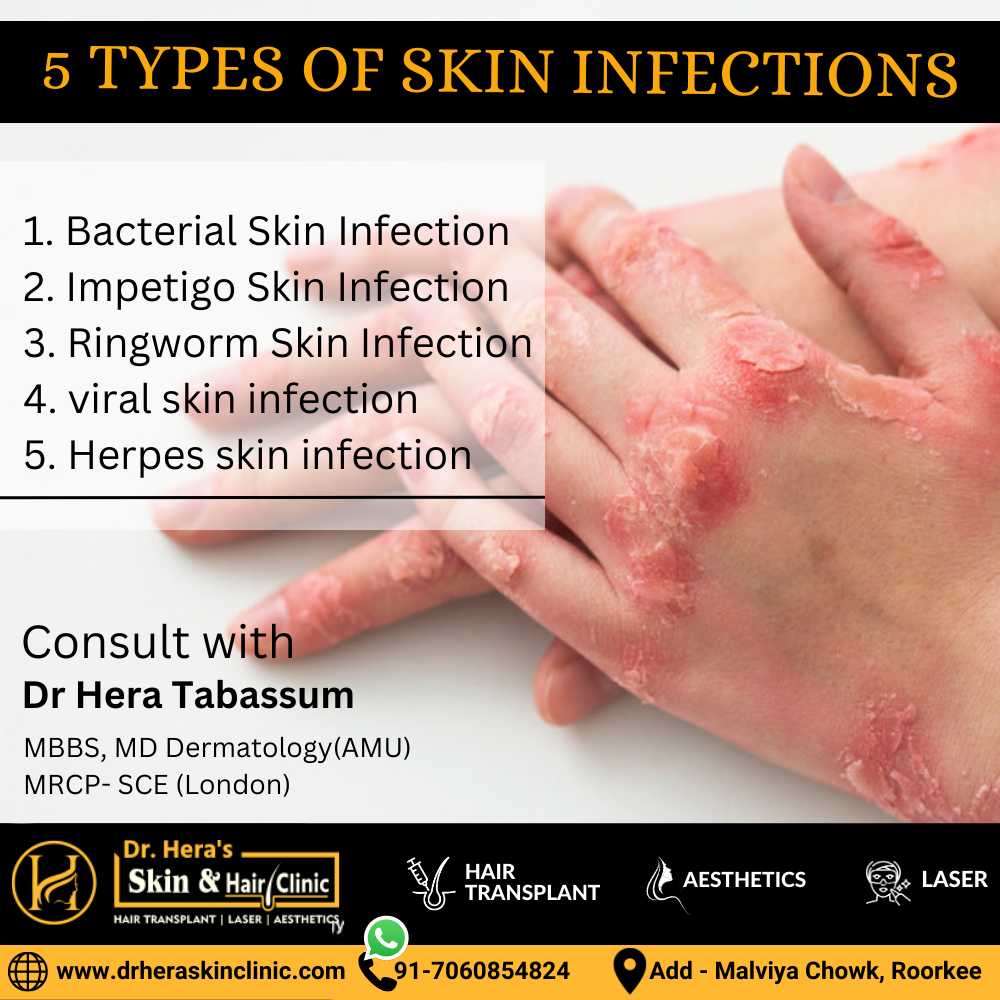Types of skin infections
Skin infections are common and can happen to anyone, no matter what age or gender they are. There are different skin infections, and each has its causes, signs, and treatment methods. Let’s say you’re worried about your skin. In that case, it’s best to talk to a dermatologist in Roorkee, like Dr Hera Tabassum, who can give you the best advice and treatment options.
Here are five kinds of skin infections:
Bacterial Skin Infections
Bacterial Skin Infections: These can happen anywhere on the body and are caused by bacteria. They can cause redness, swelling, pain, and fever, among other things. Impetigo, cellulitis, and folliculitis are all common bacterial skin infections.

Impetigo Skin Infection
Impetigo is a skin infection often found in children and can spread easily. It usually looks like red sores on the face, arms, or legs that can turn into blisters and harden into a crust. Cellulitis is another skin infection caused by bacteria that can make the skin red, swell up, and hurt. Most of the time, it happens in the legs, but it can happen anywhere on the body. Folliculitis is an infection of the hair follicles caused by bacteria. It can cause bumps on the skin that are itchy or hurt.
Skin infections caused by fungi can happen in different places on the body. They can cause redness, itching, and flaking of the skin. Ringworm, athlete’s foot, and yeast infections are all common skin infections caused by fungi.
Ringworm Skin Infection
Ringworm is an infection caused by a fungus resembling a red ring on the skin. It can happen anywhere on the body, but the scalp, feet, and groin are where it happens most often. An athlete’s foot is another type of fungal infection that causes redness, itching, and scaling on the feet. Yeast infections can happen in the mouth, on the skin, and in the genital area.
viral skin infection
Viruses cause viral skin infections and can cause rashes, blisters, and fever, among other things. Herpes, chickenpox, and shingles are all common viral skin infections.
Herpes skin infection
Herpes is an infection caused by a virus that makes blisters on the skin or inside the mouth and nose. It can happen anywhere on the body but most often around the mouth and genitals. Chickenpox is a virus that causes a red, itchy rash with small blisters that spreads quickly. Shingle is a recurrence of the virus that causes chickenpox. It usually happens to people over the age of 50. It makes you break out in a painful rash with weeks-old blisters.
Parasitic skin infection
Parasites cause parasitic skin infections and can cause redness, itching, and scaling. Scabies and lice are two examples of parasitic skin infections that happen often.
Mites that live under the skin are what cause scabies, which is a parasitic infection. It gives you a red, bumpy rash and makes you itch a lot. Lice are parasitic insects that live on the scalp and eat blood. They can cause the scalp to itch and get small red bumps.
Autoimmune skin infection
skin infections happen when the body’s immune system attacks healthy skin cells because it works too hard. They can cause redness, scaling, and blistering, among other things. Psoriasis, eczema, and lupus are common types of autoimmune skin infections.
Psoriasis Skin Infection
Psoriasis is an autoimmune skin disease that lasts long and causes scaly skin patches. Eczema is another long-term problem that can make the skin red, itch, and flake. Lupus is an autoimmune disease affecting the skin, joints, organs, and other body parts.
In the end, skin infections are common and can happen to anyone.
